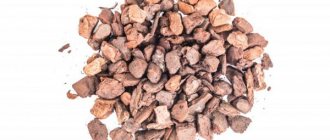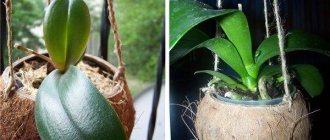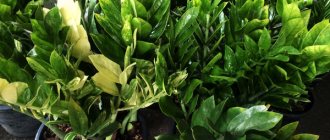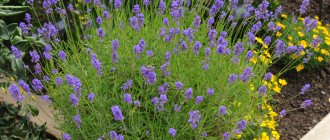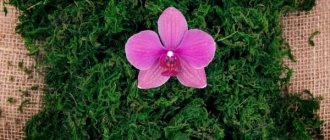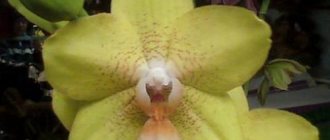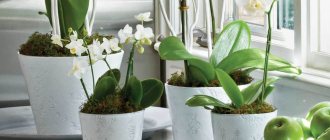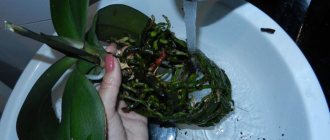Comparison with other methods
The main part of orchids are epiphytes, which in the wild are attached to tree trunks and do not require any soil. Advantages of growing soilless:
- ideal aeration of roots and access to them is ensured;
- frequent transplants are excluded;
- reduced risk of root diseases;
- an exotic look that emphasizes developmental features.
An orchid growing on a decorative driftwood will attract attention and become a spectacular accent of the interior.
The block method makes orchids more dependent on proper care.
Classification of wild flowers
Spider orchids, butterfly orchids (phalaenopsis) and even corkscrew orchids - the flowers are varied in shape and color.
Scientists believe that only 20% of the total number of plant forms are known to science . This also applies to orchids; not all species are discovered and studied.
Depending on their habitat and method of growth, plants are divided into several types:
- saprophytes - live underground and do not have the green pigment - chlorophyll;
- epiphytes - attached to the bark of trees, snags;
- terrestrial varieties.
Epiphytic species on trees
Semi-epiphytes and epiphytes grow on stumps, trees, and are attached to trunks, branches and snags. Found in rock crevices, mountains and foothills.
The roots are creeping “tentacles” that are open, branched, and grow along the perimeter in all directions. With root shoots they capture foliage and leaf litter and obtain water from precipitation and air. Thanks to the web of root shoots, they cling and are firmly held on the bark or on the surface of rocks.
Feature - the root system does not grow into the substrate; these varieties do not need soil. For life, epiphytic orchids use aerial roots and a creeping stem . Dense fleshy leaves and tubers serve as a reservoir of moisture and all necessary substances.
Epiphytic orchids on trees:
Saprophytic underground
Saprophyte flowers consist of a single shoot stem and have no leaves. They grow underground. The stem is covered with small scales; flowers form at the top. The root is compact, powerful, coral-shaped. The main rhizome does not produce branching shoots; it receives trace elements and vitamins from the substrate (humus).
Saprophytes are the most unusual of all orchids and they do not look like the flowers we are used to:
Ground
Representatives - Lady's slipper, Lyubka bifolia, Orchis . This species lives in the temperate climate zone, most often found in Europe and the USA. The varieties are medium-sized, growing no more than 50 cm in height. In the tropics, terrestrial orchids grow up to 1 m in height. They bush well and form many inflorescences.
As the seasons change, they adapt to the climate. In the warm season, root cones are formed under the soil cover, adapted to the cold winter. The plant tolerates the dormant period steadily. In spring, the flower enters a phase of active growth and produces young shoots. In summer it blooms and reproduces.
Underground tubers and roots grow in the soil. The structure of the loose substrate is :
- bark;
- roots;
- stone chips.
The soil is breathable and moist.
Some species live on the soil surface. The substrate contains :
- fallen leaves;
- roots;
- moss;
- branches;
- pieces of bark;
- small stones.
Part of the root is immersed in the soil, and part spreads horizontally across the surface. These species have a rhizome structure identical to epiphytes.
Lady's slipper:
Lyubka bifolia:
Orchis:
Which one is suitable for growing?
An orchid block is a piece of suitable material that is strong enough and resistant to rotting and deterioration.
Traditionally used:
- the bark of a cork tree, white acacia, oak, pine, or, in extreme cases, spruce;
- tree fern roots, vine;
- Styrofoam.
The size of the block is selected taking into account the volume, growth rate of the orchid and root mass, and the distance between shoots.
- A large base is required for specimens from dense families where there will be many peduncles.
- Small pieces of bark are ideal for young orchids.
The block is chosen to be whole, stable, without fragile parts or cracks , minimum thickness - 4 cm. Be sure to evaluate the risk of a possible shortage of material for the plant or the difficulty of development. The soilless method assumes that the orchid will remain growing on a support for many years.
We invite you to watch a video about the types of blocks for orchids:
Find out why Darwin was amazed by the orchid's intricate design
There is no evidence that flowering plants evolved. C. Darwin himself once Fr. 1 The orchid family is one of the largest plant families and contains about 30,000 species. Orchid flowers come in a variety of shapes and sizes, and are perhaps best known for their insect-like properties. Many orchids have very ingenious ways of attracting the insects that pollinate them, affecting both their visual and olfactory senses. Can evolutionary theory explain the origin of these orchid mechanisms?
Step-by-step instructions on how to plant a plant with your own hands
After determining the permanent location of the block, holes are made in its upper part to secure a hook or wire. Further:
- Sphagnum moss is first placed on the block.
- An orchid is placed on top. Very carefully straighten the roots so that they are freely located on the surface, cover with another layer of moss. If the flower is placed with its leaves facing down, then drops of water will not collect at the growing point.
- Secure with insulated soft wire, fishing line, synthetic thread. Do not squeeze or wrap a lot of wire. The orchid itself will gradually firmly grasp the support, and the fastening serves for general support and maintaining the given direction.
- For additional moisture retention, you can cover it with coconut fiber, pieces of tree bark or fern.
- Well watered.
Before planting, it is recommended to dry the orchid a little to make the roots more flexible.
Create comfortable conditions for orchid flowering
So let's start with the basics. We'll talk about proper watering, creating a light regime and the right temperature.
Watering
Let us remember that the orchid is negatively affected by the abundance of moisture. Both in the tropics, where the rainy period was followed by a dry period, so in our conditions, abundant, uniform watering is considered unacceptable. In this case, moisture only stimulates the growth of the flower foliage, having a negative effect on the peduncles.
At the time when the orchid fades, you should establish a period of rest, rest from water consumption. Phalaenopsis are unpretentious - they can feed on moisture from the atmosphere and reserves from the root system for a long time. At this time, it is recommended to spray the plant instead of watering.
Proper watering is carried out as follows:
The perforated (with holes) pot containing the orchid is placed in the prepared bowl for 50–80 minutes. During this time, the flower is saturated with moisture. The regularity of watering is determined by the degree of humidity in the apartment. The lower the humidity, the more water treatments for the plant. One of the main rules, following which an orchid blooms, is the presence of the required amount of water in the root system. An indicator of proper watering is the orchid roots, which take on a soft green tint.
Light mode
The lack of normal light has a primary effect on the growth of the flower, and even more so on its flowering. If there is a lack of natural light (north side of the apartment, obstacles in the form of houses that do not allow light to enter the windows), installation of lamps with phytolamps is required. The daylight hours of an orchid should last at least 10 hours of light. It is advisable to use additional lighting during the autumn-winter season.
It is also not recommended to install the flower in places exposed to direct sunlight. Orchid loves diffused light. Although, there are some types of phalaenopsis for which this indicator is not terrible.
Temperature
In a city apartment it is impossible to achieve the difference in day and night temperatures that exists in nature. But it is still necessary to try to achieve the optimal desired regime.
If conditions permit, you need to ventilate your home. The resulting freshness will refresh your pet and help reduce the room temperature. It is not advisable to ventilate a flower by placing it on a balcony or loggia, especially at night - the temperature difference can be critical.
The most optimal temperature imbalance is a five degree difference between day and night. In winter, you can use the option of placing the plant closer to the heating radiator and back.
Fertilizers
All the beneficial substances and vitamins that the orchid receives from the soil in its native land, and which are lacking in our land, must somehow be replenished. To do this you need to use fertilizers.
Mineral supplements should be introduced, which include phosphorus, potassium and magnesium. The use of nitrogen fertilizer will have to be kept to a minimum. Feeding the flower should be done at least once every ten days.
Conditions must be created in the root system to ensure photosynthesis of this important plant organ. You should also avoid sawdust, bark, and especially manure in the soil.
If all of the above conditions are neglected, all efforts to obtain a peduncle from an orchid will be useless. If you do everything correctly, but the capricious overseas guest still does not bloom, then you can use several more proven methods.
How to care for a plant?
Although the block planting method is as close as possible to the conditions of the wild, it brings even more trouble than the traditional one. Nuances of care:
- air humidity of at least 80% is required;
- the room temperature and lighting are the same for each species, regardless of the type of planting;
- during the growing season, they try to increase the influx of light, but protect from direct rays of the sun;
- sprayed and watered once every two days, but always guided by the condition of the plant, the roots were not over-moistened.
You cannot move a block with an orchid from place to place . This will negatively affect growth and flowering.
Where and how do they grow?
Orchids are a beautifully blooming decorative flower of the huge Orchidaceae family.
They belong to the class of monocots (angiosperms) . Among all plant families, this is the most extensive, there are more than 30 thousand species.
They are conventionally classified into 5 subfamilies, 22 tribes and more than 70 subtribes.
Habitats
Herbaceous perennial orchids are quite hardy . Under natural conditions, they easily adapt to any climate. The exception is the regions of the Far North and the desert, where an exotic flower simply cannot survive.
But the tropics are considered an orchid paradise. For example, the rainforest of Ecuador. More than 4 thousand species of exotics live here. There are about 20 climatic zones on the slopes of the Andes. Each one grows certain species. High humidity, gentle sun and good air circulation are ideal living conditions for epiphytic species.
Aboveground representatives of orchids have adapted well to temperate latitudes. A sufficiently developed tuberous root system provides growth and nutrition to plants. There are about 75 species here.
There is a conditional classification of climatic zones where orchids live:
- Africa, South and Central America, northeastern Australia and areas close to the equator. The climate is favorable for all varieties.
- Rocky terrain and humid mountain forests - Andes, territory of southeast Asia, Philippines, Brazil. The temperature here is lower, but the climate is always humid. Phalaenopsis live here - epiphytic, lithophytic and petrophytic species (attached to rocky and stony rocks).
- The plateaus of Brazil and the steppe areas are mainly the habitat of terrestrial representatives. Only a small part of epiphytes growing near water bodies have adapted to these conditions.
- In the temperate climates of Europe, Asia, and North America, only terrestrial orchids live.
First mentions
Orchids are one of the oldest families of flowering plants .
It appeared in the Cretaceous (late) period of the Mesozoic era, more than 70 million years ago. The first representatives became known to mankind thanks to the ancient Greek philosopher, naturalist, founder of botany and plant geography, Theophrastus. In the 4th century. BC e. he was the first to describe this mysterious plant from a scientific point of view.
This is interesting . In ancient China the flower was called lan. Theophrastus, having studied the round roots-bulbs, gave the plant a scientific name - Orchis (orchis - lit. - testicle, testes). Since then, the entire family has been named Orchidaceae.
During the era of great geographical discoveries, during one of the expeditions for gold, spices, ivory and precious stones, orchid tubers accidentally ended up in the hands of the Spaniards. Thus, at the beginning of the 16th century, the first tropical orchid, Vanilla, was discovered. One of a kind edible flower. It is currently grown in the Andean foothills of Ecuador as a spice.
The first tropical orchids were discovered in America in the 18th century and were successfully transported to Europe throughout the century.
Why do they attach to trees?
Representatives of the tropics are epiphytes (literally – “on the plant”). They grow or attach to phorophytes. Moreover, they do not absorb nutrients from them. Plants, thanks to the process of photosynthesis, receive the necessary energy and nutrition. And rains and fogs serve as a natural source of moisture.
Possible problems and difficulties
The plant is very dependent on the experience of the grower, as well as on the individual ability to adapt. Possible difficulties:
- If the orchid previously grew in a pot, it will experience stress from the air flow. A sudden change from a cramped, humid space to a drier climate often leads to the death of some of the roots. There is no need to be afraid of this, as new ones will soon appear, well adapted to the open environment.
- Maintaining constant high air humidity is the main problem of block planting. The roots will dry out much faster; frequent spraying is required.
- It is difficult to find a place in the room that meets all the parameters of a comfortable environment for a flower: constant temperature without drafts, diffuse lighting.
Experienced flower growers recommend making an impromptu mini-greenhouse. The flower is covered with it during the day to maintain stable humidity and warmth.
An orchid on a block is a good idea for decorating the interior and saving space on window sills and stands. The material for the base is chosen to be durable and large enough so that replanting is not required for many years. But this method forces you to pay special and frequent attention to the condition of the plant and the preservation of the necessary conditions.
Natural habitat of an orchid
In answering this question, it is necessary, first, to consider the natural, natural growing conditions of the orchid.
Its natural habitat is tropical forest, covered with thick foliage of phalaenopsis (the Latin name for orchids). Based on the climate conditions and place of growth, it is practically indifferent to the change of season and the length of daylight hours.
You can also note the natural conditions in which the flower grows. The rainy season in tropical latitudes gives way to drought. Both periods can last a long time – up to several months. By adapting to climate changes, the orchid stimulates itself to bloom abundantly, which can last for several months.
It is no coincidence that we gave an example of the life of a flower in natural conditions. Having moved into our apartments, the tropical beauty continues to try to maintain the same habits that were instilled in her in her homeland. Of course, we are not able to maintain similar conditions of a tropical climate in a city apartment, but we are obliged to at least follow the “rules of the game”, according to which our, in principle, unpretentious guest will live in our conditions and delight with her marvelous blooms.
Orchid flowers: complex and intricate design
The complexity of the design of most orchids belies the idea of their gradual evolution. Since the purpose of their entire complex system is to ensure the continuation of the species through pollination, without which the species would simply disappear, the logical conclusion suggests itself that every part of this device must be in its place and working correctly from the very beginning.
If an orchid had to look like a bee or other insect to attract a pollinating insect, then until the flower achieved a significant resemblance, the insect would not pay attention to it.
Classification of orchids by growth type
The structure of the orchid determines the type of flower growth - monopodial or sympodial. Figuring out what type your green pet is is not that difficult: you just need to take a good look at it.
Orchids of monopodial type (phalaenopsis, vanda, agrekcum, aerangis)
These orchids only grow upward throughout their lives. Moreover, each new sheet is slightly larger in size than the previous one. When the plant matures, the leaf plates acquire the same size. The roots of monopodial type orchids grow “haphazardly”, i.e. may even appear on the stem - and this is normal.
Orchids of the sympodial type (cymbidium, cattleya, oncidium, cambria)
These are bushes consisting of several shoots. The rhizome of such orchids is located horizontally and is called a rhizome. All upper shoots grow vertically. A structural feature of the sympodial type orchid is the presence of a pseudobulb (or false bulb) - a thickened shoot in the lower part of the plant. The flower arrow in orchids of the sympodial type can appear both from the base of this very bulb (Miltonia) and from the tip of the shoot (Cattleya).
Orchid flowers: devices and tricks
Darwin was fascinated by orchids. In his work “The Origin of Species,” he mentioned the “inexhaustible variety of devices and contrivances” with the help of which orchids ensure pollination. He emphasized that for the formation of such adaptations, changes in every part of the flower would be necessary. 2 However, Darwin did not even try to explain how natural selection could gradually create orchids capable of imitating insects so closely that the insects themselves fell for their deception. He simply described these structures as "a collection of many inherited changes", which in itself is not an explanation, but merely an opinion.
Modern evolutionists also cannot give a convincing answer - they only argue that orchid flowers and insects evolved simultaneously to complement each other. Gordon Retray Taylor was an evolutionist, but he also had many difficult questions about this theory. Regarding orchids, he wrote: “Most variations in the form of orchids have little or no selective value, at least one variation does not appear more favorable than another.” 3 He also noted that, for example: 4 “The Lady’s Slipper Orchid species has an extremely complex fertilization system and is on the verge of extinction.”
Links and notes
- From a letter to botanist Joseph Hooker, 1881. Return to text.
- Charles Darwin, The Origin of Species, Mentor, New York (NY), 1958, p. 179. Return to text.
- The Great Mystery of Evolution, Secker & Warburg, 1983, p. 163 Return to text.
- Link 3, page 232. © 1996, Creation Resources Trust. Return to text.
Jeff Chapman
is the honorary secretary of the Creation Society in England, which deals with issues of Creation. He preaches, works with children, and is also the author of the “Our World” section in Creation magazine.
In tropical latitudes there grows a flower of equal beauty that is difficult to find. Its name is as unusual and exotic as its appearance - orchid.
Many flower growers want to admire this unusual creation not in the tropics, but at home, so they ask the question - how to make this capricious beauty bloom while in a harsh climate?

